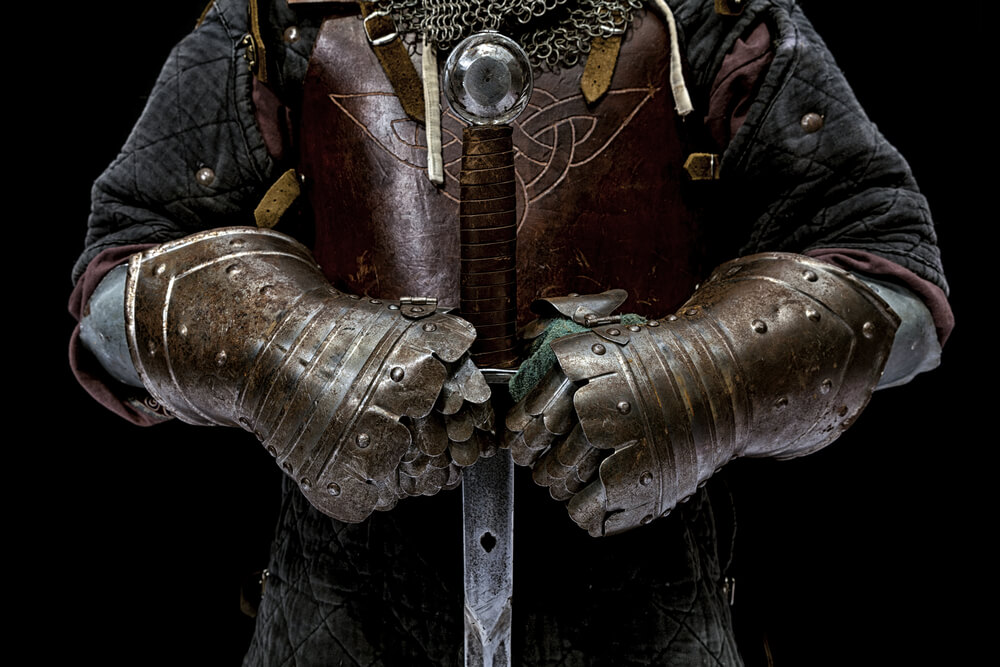10 Facts About Medieval Knights and Chivalry
Posted by MRL on May 28th 2019

From Game of Thrones & Kingdom of Heaven to Excalibur and Camelot and its Knights of the Round Table we have no shortage of stories of daring-do and chivalrous acts about knights. But what do we really know about them? We know they wore armor, rode on horseback and fought...a lot, even for fun. There was more to them than that of course, here are some odder things we know about knights-
#1 The Word Knight
It translates to servant, how humble is that? Not what most people envision when Lancelot comes striding in on his white stallion. It's true, their job was to serve Lords and Kings as soldiers, landlords and justice bearers and eventually take on the role of protecting pilgrims that could not protect themselves as we saw during the many Crusades.
#2 Pillage
Yep, they did and really did it nasty. Not all of course, but war and fighting tend to bring out the bad in people. Knights fought often for the rights to rape, pillage and plunder. It was one of the few ways available to them to create a reputation, acquire and grow their wealth. Ironically, it was the knights of religious orders that often made a pledge to God and the Church of poverty and chastity which were thrown aside when the opportunity struck.
#3 Training
A knight's training was long and arduous and would begin at age seven and lasted for a total of fourteen years. The potential knight would first serve as a page- really just a servant boy who had to run errands and serve his lord which allowed him to become acquainted with the basics of a squire and his possible knightly duties. Much of the training focused on games and sports; however, they were extreme games. Instead of toys and tag, a page played with maces and worked on his horsemanship.
#4 At 14, provided you did nothing egregious and were still in good physical health, the page moved on to become a squire. Most served a specific knight, acting as a personal assistant of sorts which included helping to dress the knight and maintain his armor and weapons. After seven plus years of training, a squire certainly had some fighting prowess and was capable of fighting on a battlefield. It was through this phase that training became more serious and took place in real life situations. As a result, they suffered frequent injuries along with the knights, but as you healed and learned you advanced to ever more traditional knightly skills such as jousting and hand to hand combat with blades, clubs and maces. Fighting was part of the daily training regime.
#5 At 21, the squire could be knighted if deemed to have adequately passed his training and again remained healthy enough to take on his knightly responsibilities. The dubbing process was very simple and had none of the ceremony we've come to expect today. The noble presiding over the transition would basically slap the squire on the neck and shoulder area with an open hand and utter a few words. It was the Church that turned the dubbing into the ceremonial event we now see in books, movies and TV shows. Pledging your loyalty in pomp and circumstance held greater meaning and had the effect of strengthening the bond of a knight to his Lord.
#6 Jousting
Not just for training, but a way to stay in shape between conflicts and it sure could be a visual spectacle. Who doesn't like the sound of lance and armor clashing at as much as 25 mph? Your going 25, your opponent is going 25 and bang! Ouch, just like a car crash. It became a way for a knight to prove his worth to spectators even in times of peace, making him a celebrity or sorts and turned jousting eventually into the sports-like event that we see today. So, although it began as an exercise in combat tactics, it became, in medieval terms a hastilude- a combat-themed sport.
#7 Armor
No knight could imagine entering the battlefield without his armor. A suit of plate steel that was attached via leather buckles. Customizing was necessary and many suits had pieces that needed to be custom made to allow the wearer to move as freely as possible. Full plate armor was complex and could weigh as much as 50 pounds (jousting armor could reach 100 lbs.) and as a result it's a common myth that a fully suited knight was like a turtle- not very mobile and once down, that was it. Over a decade of training being around and using these suits made them physically fit and very mobile. Like a well-oiled machine. They could mount a horse and rise in battle as many times as their strength allowed. They'd be no good to anyone in battle if they were so one dimensional. How could they storm a castle and make their way up steps? They did and did it well. You have to remember the weight of all that metal was attached to various other pieces and many body parts distributing the weight for a very mobile soldier. None of the weight was concentrated in any one area to bog them down.
Armor was not only strong defense, but also a status symbol. The higher the quality and workmanship, the more important the knight was thought to be. Sometimes a suit or parts could be won in combat and tournament which made the knight seem all the more dangerous in battle.
#8 Chivalry
This was nothing more than a loose set of rules that guided a warrior in proper knightly conduct. It was actually not well defined until later literature romanced it and did it for us. That said, it often extended beyond the battlefield into everyday life. The codes of conduct and etiquette could be strict, but at their core were the vows a knight made during his dubbing ceremony. Some vows included:
A knight should never willingly or knowingly associate with traitors.
A knight should never give evil counsel to a lady and should always treat her with respect and defend her honor against any danger.
The Church saw this as a way to insert a few extra rules like attending Mass regularly and making offerings. What's more all knights were to take part in fasts and abstinence. Involving themselves allowed them to manipulate and rally knights to their cause for the Crusades. The Church now had an army.
And although these ideals were commonplace at social events, not many knights kept to these ideals when they entered battle. Instead, most opted to butcher and pillage as much as they could. They were soldiers and practical men and smart enough not to risk getting killed because their opponent just may not follow the same rules. And let's face it, who was watching? If they could get away with it, well...
#9 Arbalest
What? How did a crossbow get into this? Knights were supreme on the battlefield, what could possibly ruin such a great system of warfare? Ironically, their end was brought about by a very simple improvement to an old weapon, the wooden crossbow. The arbalest was created in the 12th century and was a mega crossbow of sorts. Due to better materials and more advanced understanding of forging, it could now be made of steel which was tempered to have a strong spring effect. This allowed it to endure much higher tension than ordinary bows and produce greater force. An arbalest was accurate up to 300 meters, nearly a thousand feet! And it proved relatively quick to reload, and very easy to operate with minimal training. Most important, its bolts could puncture armor. Suddenly, the mighty knight with all his combat skills, sturdy armor, and lifetime of training was an easy target for an ordinary guy who had just been trained for a few weeks. A skilled arbalestier could drop two knights a minute, and stay safely out of harm's way.
Although unchivalrous at its core, it was a sign that the dominant force on the battlefield was nearing an end, especially with gunpowder weapons on the horizon. Not to be outsmarted, many knights had grown wealthy and could afford to avoid this potential threat by striking deals to buy their way out of the combat. The king allowed this as he could then purchase many soldiers to fight in the knight's place. The payment was known as "shield money" and was even more effective than any wooden or metal shield a knight could carry into battle.
#10 Today
Since the mid 1500's, knighthood has ceased to exist as a solely military honor. There are still a few knighthoods granted for military endeavors today, but most are bestowed because of the contributions a person has made to their nation like a medical breakthrough, philanthropy or the arts. For example, the knighthoods given to famous people such as Sir Elton John, Dame Judi Dench, Sir Ronald Reagan, Sir Bill Gates, Sir Patrick Stewart and Sir Paul McCartney are purely honorific and fortunately do not require them to saddle up.


